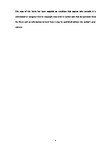The effects of lateralisation on detour based problem solving in horses (Equus caballus)
| dc.contributor.supervisor | Randle, Hayley | |
| dc.contributor.author | Savin, Hannah | |
| dc.contributor.other | Faculty of Science and Engineering | en_US |
| dc.date.accessioned | 2015-08-07T13:02:54Z | |
| dc.date.available | 2015-08-07T13:02:54Z | |
| dc.date.issued | 2015 | |
| dc.date.issued | 2015 | |
| dc.identifier | 398747 | en_US |
| dc.identifier.uri | http://hdl.handle.net/10026.1/3512 | |
| dc.description.abstract |
Potential impact of motor laterality on equine performance has resulted in research into this aspect of equine behaviour. Many studies demonstrate that equids exhibit a preference for one side over the other but there is little evidence for directional biases. In modern day equestrian practices, equids are frequently required to manoeuvre around objects and laterality preferences may hinder or aid in this movement. The aim of this study was to investigate if horses consistently show a directional preference during a detour task. Twenty three horses of various breeds, ages and sexes were required to obtain a goal, a piece of carrot placed in a food bucket located behind a barrier. Horses were started from an initial position of 4 metres from the goal. Each horse was released simultaneously after observing the carrot being placed in the bucket. The time (s) taken from release to reach the goal was recorded where the subject was considered to have attained the goal once it touched the carrot. A maximum duration of 180s was allowed to achieve the goal. Successful trials were followed by extension of the barrier-goal distance at 2m intervals until a maximum length of 8m was reached. If a horse failed to complete a trial within 180 seconds the trial was terminated. An additional study was conducted to determine whether horses consistently show a directional preference in their detour behaviour, regardless of distance to the goal. Five horses completed the task and there was no directional bias evident during the detour task χ2(1, N = 5) = 6.4, p > .05, with only one horse showing a directional bias to the left. The 4m trial was successfully completed by 15 horses, 6m trial was completed by 12 horses and the 8m trial was completed by 12 horses. At 4m there was a greater tendency to manoeuvre around the object to the left as opposed to the right χ2(1, N = 15) = 8.07, p < .05). There was no significant difference in the direction moved at the 6m trial χ2(1, N = 12) = 0.6, p > .05 or the 8m trial χ2(1, N = 12) = 1.33, p > .05. There were no significant differences in the solving times exhibited for each trial H2=1.37; P > .05, performance did not improve during subsequent trials. The exhibition of lateral preference changed as the detour tasks became increasingly difficult. The fact that solving times did not change throughout subsequent tasks may imply learning during this task did not occur. The overall absence of laterality biases in this study could be attributed to lack of congruity between ability of subjects and experiment requirement. This finding has importance for future studies as it must be recognised that horses should not be required to perform task outside of their behavioural ability and repertoire. This finding can be applied within the equestrian practical context for example when training and preparing horses for work. | en_US |
| dc.language.iso | en | en_US |
| dc.publisher | Plymouth University | en_US |
| dc.subject | Animal Behaviour | |
| dc.subject | Horse | |
| dc.subject | Equine, Laterality | en_US |
| dc.title | The effects of lateralisation on detour based problem solving in horses (Equus caballus) | en_US |
| dc.type | Masters | en_US |
| plymouth.version | Full version | en_US |
Files in this item
This item appears in the following Collection(s)
-
01 Research Theses Main Collection
Research Theses Main


